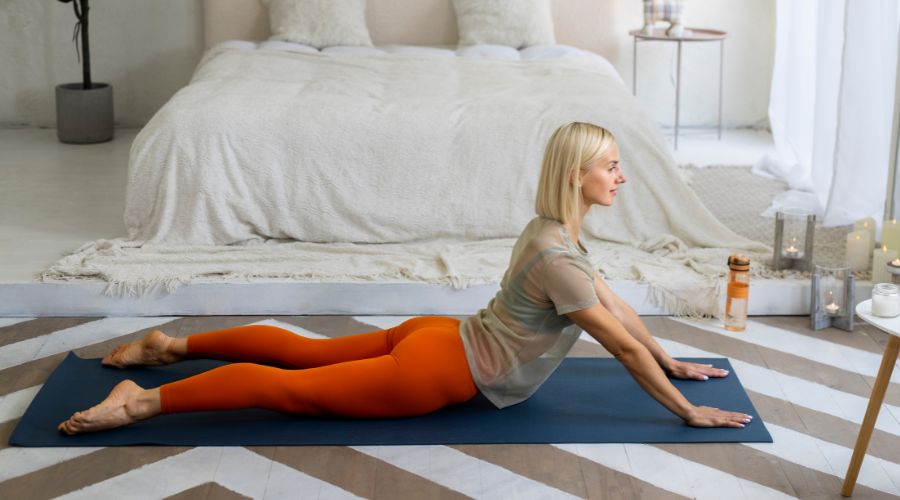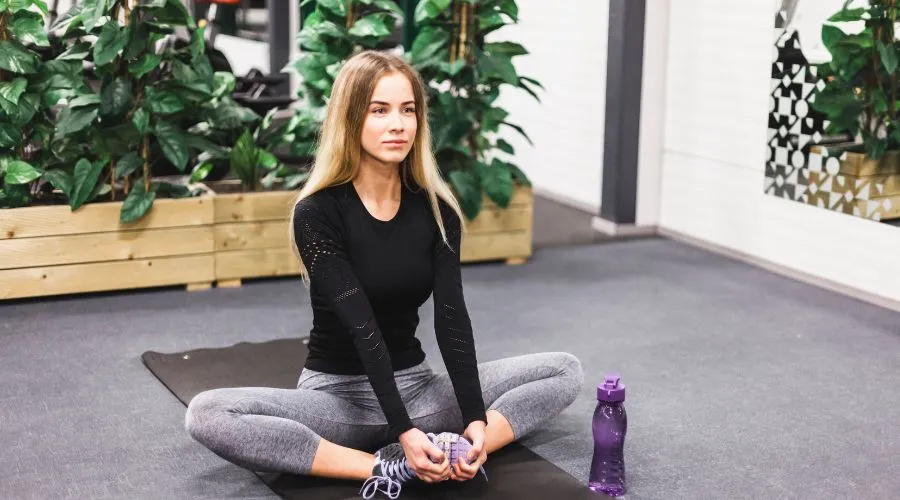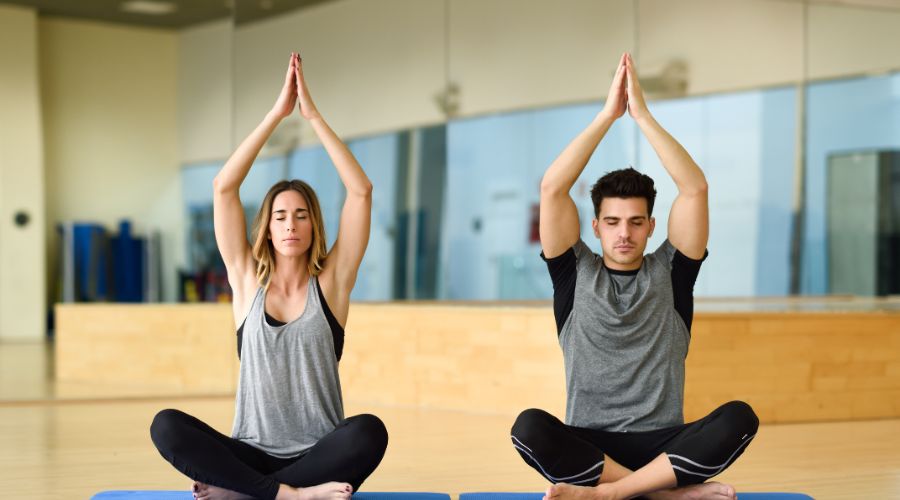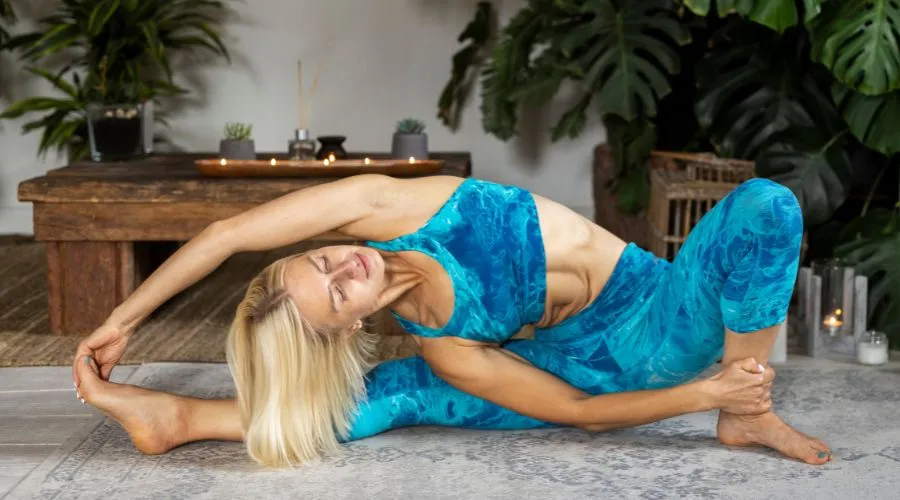Somatic Yoga Exercises Anyone Can Try at Home
Feeling troubled by stress and body stiffness? Somatic yoga is a gentle solution that any beginner can try at home. These exercises help release tension and restore body-mind balance.
Somatic Yoga — A practical, science-backed guide for beginners
Do you ever feel stuck inside your body — tight hips after sitting, a neck that never relaxes, or stress that shows up as pain? You’re not alone. Many people try to “stretch harder” or push through pain, and end up feeling more disconnected or frustrated. If you want gentle, reliable ways to calm your nervous system, reduce chronic tension, and actually feel safer in your body, Somatic Yoga gives you tools that work from the inside out.
This guide gives a complete, easy-to-follow Somatic Yoga plan: what it is, the science behind it, 14 beginner-friendly exercises (with cues, variations, and common mistakes), sample routines (20, 30, 45 minutes), a 6-week progression plan, safety notes, and FAQs. It’s longer and more practical than most posts on the topic — including the linked competitor guide — and filled with action steps you can use today
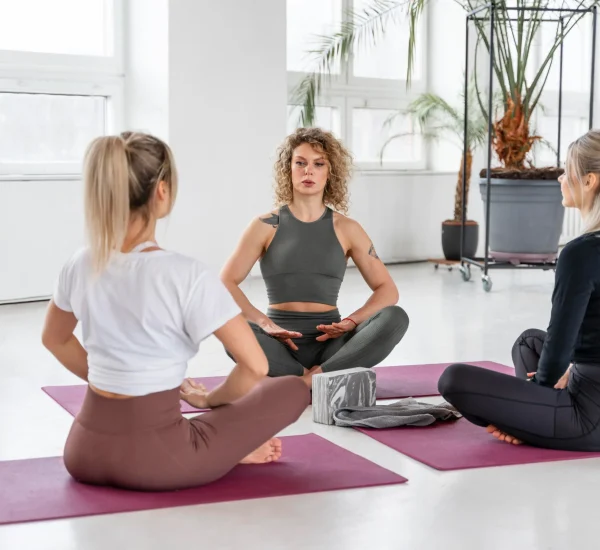
What is Somatic Yoga? (short, clear definition)
Somatic Yoga is an embodied movement practice that blends slow, mindful movement and breath awareness with somatic principles (interoception, proprioception, and nervous-system attunement). Unlike a goal-oriented yoga class focused on alignment or achieving shapes, Somatic Yoga asks: what does it feel like inside the body? You move with curiosity, sense internal sensations, and use gentle movement (and sometimes pandiculation — controlled re-patterning of muscle tone) to retrain the nervous system.
Key semantic terms to know: interoception (sensing internal body signals), proprioception (sense of where your body is relative to space), pandiculation (a natural, nervous-system-driven stretch/release), vagal tone (vagus nerve activity linked to calmness), and body-map updating (changing how your brain represents movement). These ideas show up throughout this guide
Why Somatic Yoga works — science & evidence (short summary + citations)
Somatic approaches are rooted in clinical traditions (Somatic Experiencing®, Clinical Somatics, Feldenkrais, etc.) and growing research shows they can improve pain, interoceptive awareness, and emotional regulation. Clinical and review papers suggest somatic practices can reduce chronic pain and PTSD-related symptoms when combined with trauma-informed methods; improved interoception from body-based practices helps regulate emotions and stress responses. PMC+2PMC+2
Pandiculation — taught explicitly in many somatic systems — is increasingly recognized as a nervous-system tool to reset chronic muscle tension (research on pandiculation and its role in myofascial health is available). Somatic movement programs also show benefits for mobility and body awareness in clinical and aging populations. PubMed+1
Bottom line: Somatic Yoga acts on the nervous system (not just the muscles). By giving your brain gentle, safe movement input and refining internal sensation, you can retrain habitual tension patterns and reduce pain and reactivity over time.
How Somatic Yoga differs from regular yoga or stretching
Focus: Internal sensation > external form. Somatic Yoga intentionally slows things so you can notice subtle changes.
Tempo: Very slow, micro-movements, pandiculation, and stillness rather than dynamic flows.
Goal: Update the brain’s body map and reduce defensive muscle tone, not to hit a pose.
Tools: Breath, interoceptive scanning, guided attention, small-range contractions/lengthenings, and nervous-system cues.
Tone: Trauma-informed, invitational, and permissive — you’re invited to follow sensations, not push them.
How to practice safely (before we begin)
Practice in a quiet space where you won’t be rushed. Use props: blanket, pillow, bolster, blocks.
Move inside your comfort window. Discomfort is okay; sharp pain is not. Back off if something hurts.
If you have major medical conditions (recent surgery, unstable cardiopulmonary disease, uncontrolled migraines, pregnancy complications, serious neurological illness), check with a healthcare provider first.
Track sensations, not performance. Jot brief notes after practice: 1–3 words about how you feel (e.g., “less tight, calmer, lighter”). This helps you detect progress beyond appearance.
Top 14 Somatic Yoga exercises for beginners (expanded & improved — more than the competitor’s list)
Below are clear actions: how long, how to do it, what to feel, variations, common mistakes, and benefit summary. Use the target keyword “Somatic Yoga” naturally in each section.
1) Full-Body Scan (5–12 minutes) — foundational
Why: Builds interoception and trains attention to internal cues.
How-to: Lie or sit comfortably. Close eyes if safe. Slowly bring attention to your feet, ankles, calves, knees, thighs, pelvis, lower back, abdomen, chest, shoulders, arms, neck, head — pausing 5–10 seconds on each region. Notice temperature, tension, breath movement, small vibrations, or emotional impressions. Breathe slowly and invite a soft, curious tone.
What to feel: Neutral noticing; try to label sensations (e.g., “warm,” “tight,” “buzzing”) without judging.
Variation: Guided voice (record yourself or use a recording). Use a body-scan script to help beginners.
Common mistakes: Trying to “fix” sensations during scan — scanning is mapping, not correcting.
Benefit: Improves body awareness and primes the nervous system for further somatic work. (Competitor includes this — expanded here with labeling practice).
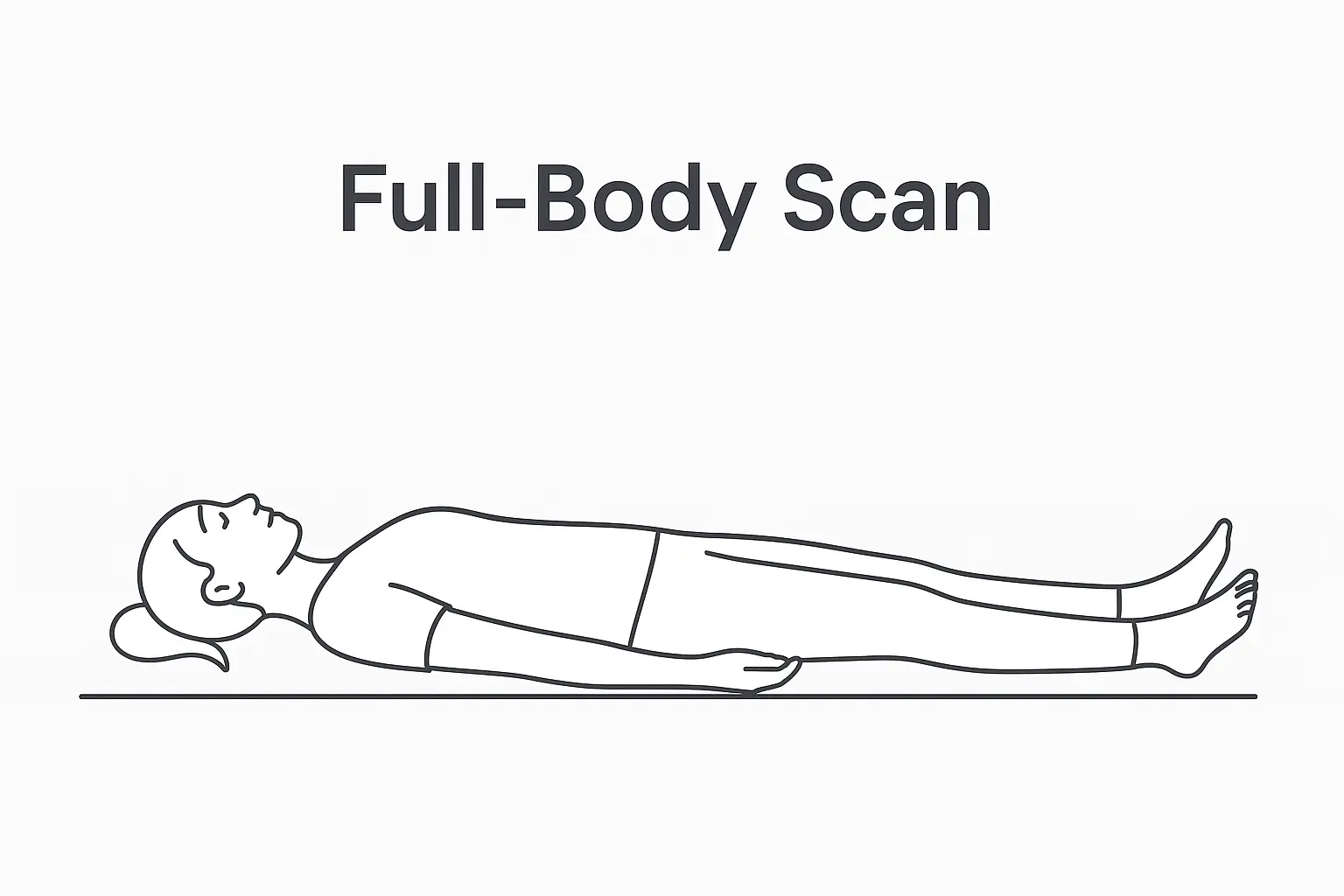
2) Gentle Breath + Diaphragmatic Bulge (3–5 minutes)
Why: Breath is the quickest lever on the autonomic nervous system.
How-to: Lie on back, knees bent. Place one hand on chest and one on belly. Breathe into the belly so the lower hand rises first; feel a gentle bulge under your lower ribs. Exhale slowly, feeling soft release. Keep breaths 5–6 seconds in/out if comfortable.
What to feel: Belly expand and soften; relaxed jaw and shoulders.
Variations: Seated belly breathing if lying is not possible. Add a 2-second hold at the top to increase interoception.
Common mistakes: Lifting shoulders or chest as primary movement (that’s thoracic breathing — still useful but less calming).
Benefit: Calms the nervous system and increases interoceptive signal clarity.
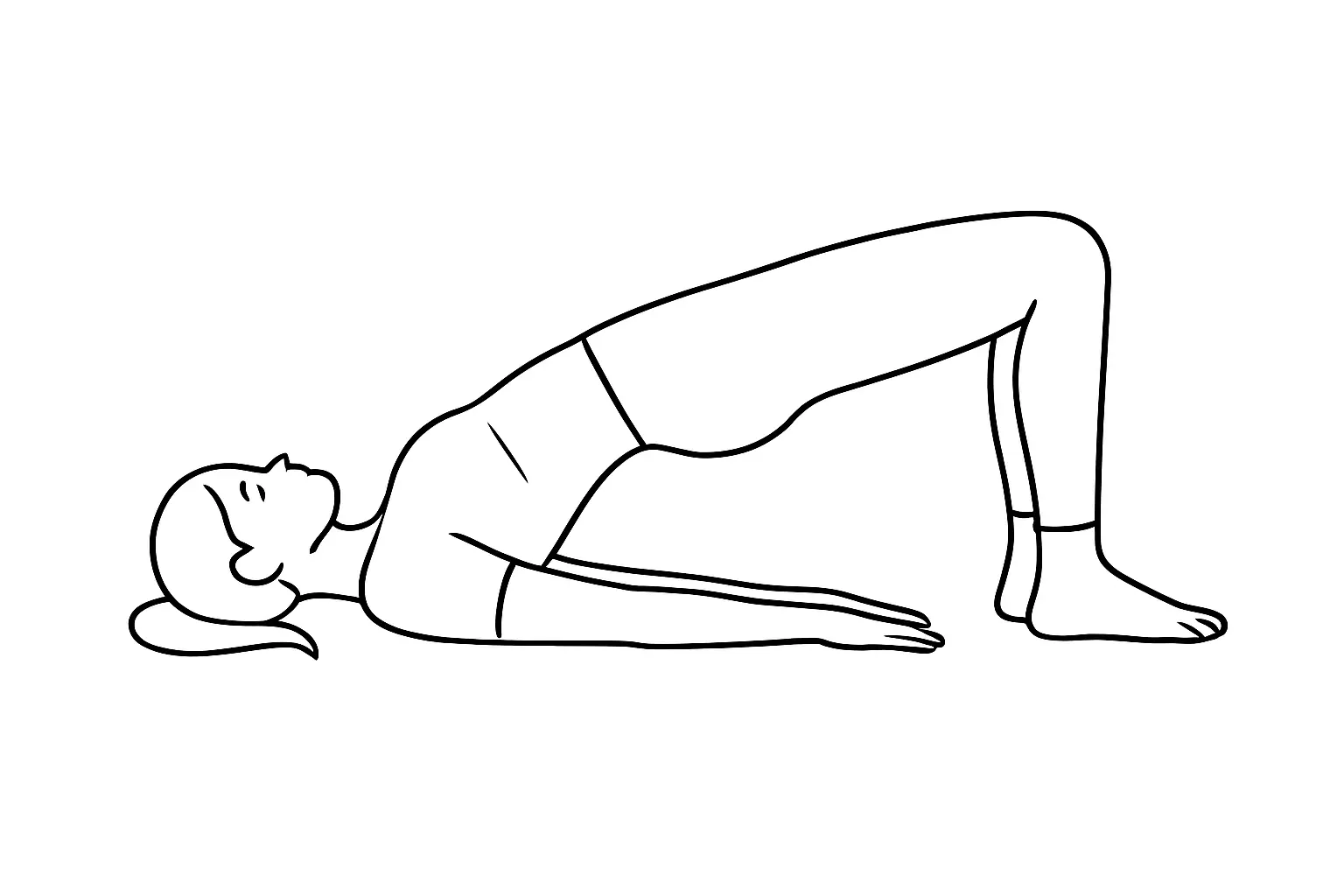
3) Moving Bridge (pelvic undulations) — 5–8 minutes
Why: Releases lower back, re-patterns pelvic tone, awakens spine segmentation.
How-to: From supine, knees bent, feet hip-width. Gently rock pelvis forward/back to find movement. Then slowly articulate the spine up into a bridge—lift tailbone, lower back, mid back, then upper back—vertebra by vertebra. Pause, then articulate back down one vertebra at a time. Sync breath with movement. Move tiny ranges and notice inner sensations as you lift and lower.
What to feel: How different spinal segments light up; where breath moves.
Variations: Support sacrum on a block and explore tiny tail wagging instead of full lifts.
Common mistakes: Straining to a “high” bridge instead of mindful articulation.
Benefit: Neuroplastic retraining of low-back control; useful for chronic back stiffness. (Competitor uses this — we add micro-range options and supports)
4) Knee Rock with Cactus Arms (supine, rocking + shoulder release) — 5 minutes
Why: Mobilizes lumbar spine and calms thorax via arm position (cactus arms = openness).
How-to: Supine, knees bent, feet wide. Arms in cactus (elbows bent 90°, arms out). Rock knees left-to-right with a slow breath rhythm. Optionally turn head opposite to knees for somatic cross-cueing. Notice where the spine resists or gives.
What to feel: Pelvic shifts, softening through ribcage and diaphragm.
Variation: Place a bolster under knees to reduce range.
Common mistakes: Quick, bouncy rocking — keep it slow and exploratory.
Benefit: Gentle mobilization + interoceptive feedback; can release trapped tension in ribs and shoulders.
5) Half Wind Removing / Knee pull with core awareness (supine) — 3–6 minutes each side
Why: Helps digestion, pelvic mobility, and low-tension core activation.
How-to: Supine, hug one knee into the chest. Hold mindfully — notice abdominal engagement and where breath goes. Optionally press shin into hands to create gentle resistance then relax (isometric cue), or lift head and chest slightly to intensify abdominal sensation. Then slowly release. Mirror on other side.
What to feel: Compression vs. release in hips; breath moving into belly during compression.
Variation: Keep both knees bent and do alternating pulls for easier option.
Common mistakes: Holding breath. Breathe rhythmically.
Benefit: Teaches core sensation and reduces pelvic guarding.
6) Seated Torso Circles (mindful spinal mobility) — 3–6 minutes
Why: Restores spinal mobility and refines pelvis-spine relationship.
How-to: Sit cross-legged or on a chair. Place hands lightly on knees. With soft focus, draw small circles with your torso, moving from tailbone > lumbar > thoracic > cervical. Keep range small and breathe into movement. Reverse direction. Pause and note difference left vs right.
What to feel: Where movement is easy vs. restricted.
Variation: Use chair for more stability or add a hand to the belly to sense core-driven motion.
Common mistakes: Using neck to lead; initiate from low ribs/pelvis.
Benefit: Re-maps spinal motion and reduces reactive guarding.
7) Seated Side-Body Breath & Reach — 2–4 minutes each side
Why: Releases lateral tension and improves rib mobility.
How-to: Sit tall. Place left hand on right thigh. Inhale, reach right arm up; exhale, lean gently left. Breathe into the right side ribs. Hold, then return slowly. Compare both sides.
What to feel: Increase in breath depth and space between ribs.
Variation: Use strap if reaching is limited.
Common mistakes: Collapsing the chest—keep length on inhale.
Benefit: Helps expand breath and soothes sympathetic arousal.
8) Sphinx + Half-Frog (prone openings) — 4–6 minutes
Why: Gentle anterior chain opening; interoceptive access to front body.
How-to: Lie prone. Slide elbows under shoulders and lift into Sphinx. Breathe into the belly and front ribs. Optionally bend one knee, opening the hip (half-frog) slowly while breathing into the hip and lower belly. Explore gentle rocking if that feels safe.
What to feel: Softening in chest, activation patterns in back muscles.
Variation: Props under hips if lower back sensitive.
Common mistakes: Overarching quickly; instead, micro-move and observe.
Benefit: Opens fronts of body and enhances nervous-system tone regulation.
9) Extended Child’s Pose + Pandiculation (rest + spontaneous stretch) — 3–6 minutes
Why: Pandiculation is a nervous-system-led stretching pattern that helps reset tone. Research highlights pandiculation’s role in maintaining myofascial health and transitions between states. PubMed
How-to: From all-fours, walk knees wider, big toes touch. Fold to Child’s Pose. Breathe into spine, then invite a slow animal-like stretch: spread fingers, reach arms forward, gently arch and lengthen like a cat yawning, then return to rest. Notice what changes in muscle tone. Repeat slowly.
What to feel: Waves of lengthening and softening as muscles “unlearn” constant tension.
Common mistakes: Forcing a big stretch — pandiculation is slow and voluntary but gentle.
Benefit: Resets chronic muscle tone and increases sense of safety in movement.
10) Gentle Neck Circles (seated) — 2–3 minutes
How-to: Sit upright. Imagine a pencil at the crown drawing small circles on the ceiling. Keep jaw soft, eyes relaxed. Start small, then slightly larger. Reverse. Always move slowly.
What to feel: Subtle shifts in trapezius and jaw; breath into upper chest.
Variation: Perform with chin tucked slightly for a safer range if you have neck issues.
Common mistakes: Rolling too large/fast or compressing the back of the neck; maintain length.
Benefit: Helps downregulate shoulder tension and jaw clenching.
11) Pelvic Clock (supine micro-tilts) — 3–5 minutes
Why: Refines pelvic proprioception and low-back control.
How-to: Lie supine, knees bent. Imagine your pelvis as a clock. Slowly tilt toward 12 (anterior), 6 (posterior), 3 (right), 9 (left) — or make a small circular sweep. Keep movements tiny and breathe into the area you move. Observe which “time” feels sticky.
What to feel: Minute shifts in low-back and glute activation.
Variation: Use feet wider to change pelvic feedback.
Common mistakes: Large levered movements; this is about subtle neural retraining.
Benefit: Great for low-back pain related to poor pelvic control.
12) Clamshell with sensory focus (side-lying) — 4–6 minutes each side
Why: Improves hip control while training internal sensation (psoas/glute ratio).
How-to: Lie on side with knees bent and stacked. Open the top knee slowly (like a clamshell), noticing where you feel movement: hip socket, lateral glute, or outer thigh. Optionally add a gentle isometric press (press knee into hand) then relax to increase feedback. Keep motion small.
What to feel: Where you actually move and which muscles light up.
Common mistakes: Using momentum or rotating pelvis; keep pelvis stacked and still.
Benefit: Effective for hip stability and for releasing emotional holding in psoas region. (Competitor mentions hips — this expands with sensory cues.)
13) Mindful Walking (5–10 minutes)
Why: Applies somatic awareness to functional movement, integrating posture, breath, and rhythm.
How-to: Walk slowly in a quiet space. Notice heel strike, weight shift, how pelvis rotates, breath depth, and any habitual patterns (e.g., stiff hip, heavy heel strike). Keep attention local — pick one feature each round.
What to feel: Whole-body integration of sensory and motor maps.
Variation: Walk 1–2 minutes eyes closed if safe, to heighten proprioceptive feedback.
Common mistakes: Speeding up; the practice is slow and investigative.
Benefit: Transfers on-the-mat learning to everyday movement.
14) Self-Hug + Grounding Sway (1–3 minutes)
Why: Somatic self-contact is soothing and practical when anxiety spikes.
How-to: Sit or stand. Wrap arms around yourself, breathe into the front body. Optionally sway gently side-to-side. Notice temperature of hands, softening in shoulder blades, and breath depth.
What to feel: Immediate calming, sense of containment.
Common mistakes: Gripping too hard — keep it loving and soft.
Benefit: Fast nervous-system down-regulator; useful at work or in public places.
Putting the exercises into practice — sample routines
Below are ready-to-use micro-workouts. Choose one based on available time.
20-minute “Reset” (daily)
Full-Body Scan (4 min)
Breath + Diaphragmatic Bulge (3 min)
Pelvic Clock (3 min)
Clamshells (2 min each side)
Self-hug + Grounding Sway (2 min)
Finish by noting one change in sensation.
30-minute “Calm & Open” (3x/week)
Full-Body Scan (5 min)
Moving Bridge (6 min)
Seated Torso Circles + Side Body ~ (6 min)
Sphinx + Half-Frog (5 min)
Extended Child’s Pose + Pandiculation (4–6 min)
45-minute “Deep Reset” (1–2x/week)
Full-Body Scan (7 min)
Breath practice + Diaphragmatic Bulge (5 min)
Moving Bridge (8 min)
Knee Rock + Cactus Arms (5 min)
Pelvic Clock + Clamshells (8 min)
Mindful Walk (5 min)
Savasana or Long Rest (5–10 min)
6-Week Starter Progression (goal: retrain comfortable ranges and nervous system)
Week 1 (habits): 10–20 minutes daily — full-body scan, breath work, pelvic clock. Note sensations before & after.
Week 2 (consistency): Add 1 mobilizing exercise (moving bridge or knee rock) every other day. Continue daily scan.
Week 3 (integration): Include mindful walks twice a week; practice clamshells/hip micro-work.
Week 4 (expansion): Increase hold times; add pandiculation in child’s pose. Track pain levels and sleep.
Week 5 (functional): Do a 30-minute practice 3x/week. Bring somatic cues into daily tasks (standing desk shifts).
Week 6 (assess): Compare journal notes — tension, sleep, reactivity. Create a maintenance plan: 3–5 short sessions per week + mindful walk daily.
Measuring progress (simple metrics to track)
Pain scale (0–10) before & after practice each week.
One-sentence notes: “what changed” (“less tight in lower back,” “calmer heart”).
Objective markers: minutes to fall asleep, # of pain-free days/week, ability to bend forward/back without guarding.
Props, environment & micro-habits
Props: Blanket or folded towel, bolster, eye pillow, small block — use these to reduce stretch intensity so you can feel micro-movements.
Lighting/music: Low light + quiet or gentle ambient music helps interoception.
Micro-habits: 30-second breath check before meetings, 2-minute self-hug after phone calls, mindful walking to the kettle.
Safety, contraindications & when to see a professional
If you have structural spinal instability, uncontrolled hypertension, or are recovering from major surgery, consult a clinician before beginning.
For complex trauma: somatic practices can surface emotions. Consider working with a trauma-informed somatic therapist if intense memories or panic arise. Research suggests somatic approaches can help PTSD symptoms but are best integrated with mental-health support for some people. PMC
If an exercise produces sharp, shooting pain, stop. If pain persists, see a physiotherapist or physician.
Evidence & references (short reading list)
Principles connecting somatic practices and pain management: Moving With Pain (review). PMC
Randomized trials on somatic approaches for trauma/chronic pain: Somatic Experiencing RCTs. PMC
Interoception and contemplative practice: Frontiers / PMC review (interoception → emotion regulation). PMC
Pandiculation research and myofascial integrity. PubMed
Somatic movement intervention improving mobility in older adults. ScienceDirect
(For background on common Somatic Yoga exercises and an approachable beginner list, see the competitor article we analyzed; this guide expands that list and adds routines, progression plans, and evidence summaries.)
Also Read: Yoga Exercises for Anxiety Guide – simple poses to calm your mind & body.
Final Thought
Your body is not just a machine; it’s a living, sensing, intelligent system that responds to every breath, thought, and movement you make. By practicing these 10 somatic yoga exercises, you’re not only stretching muscles — you’re retraining your nervous system, unlocking stored tension, and reawakening your body’s natural rhythm.
Somatic yoga works because it speaks the language your body understands: slow, mindful, and intentional movement. This activates the brain’s sensory-motor pathways, helping you release patterns of pain, stiffness, and fatigue that traditional workouts often overlook.
Remember — consistency beats intensity. Even 10–15 minutes a day can transform how you feel, move, and think. Start small, listen to your body, and let the changes unfold naturally. Over time, you’ll notice not just more flexibility and strength, but also a deeper sense of calm, confidence, and connection with yourself.
Your body already knows how to heal — somatic yoga simply shows it the way.
FAQ?
Q: What is Somatic Yoga good for?
Somatic Yoga is especially good for calming the nervous system, reducing chronic tension, improving body-awareness (interoception), and gently improving mobility. It’s used for stress, many forms of chronic musculoskeletal discomfort, and as an adjunct to trauma-informed therapy. Evidence points to improvements in pain perception and functional mobility when somatic principles are applied consistently.
Q: Is somatic yoga the same as regular yoga?
No. Somatic Yoga prioritizes internal sensation and nervous-system retraining through small, mindful movements. Traditional yoga may focus more on alignment, strength, or pose sequences. Both can complement each other.
Q: How often should beginners practice Somatic Yoga?
Start with short daily sessions (10–20 minutes) or 20–30 minutes 3–5 times a week. Consistency matters more than intensity — frequent, gentle input is what updates the nervous system.
Q: Can Somatic Yoga help anxiety?
Yes. Somatic practices enhance interoceptive awareness and breathing patterns that help regulate the autonomic nervous system, which often reduces anxiety symptoms when practiced regularly.
Q: How long before I see results?
Many people notice short-term effects (feeling calmer or less rigid) within a few sessions. For lasting changes in chronic patterns, expect 4–8 weeks of consistent practice. Track objective markers (pain scale, sleep) for clearer feedback
Q: Is Somatic Yoga safe for people with chronic pain?
Generally yes, when performed gently and with attention to sensation. Start with guided practices, micro-movements, and consult a healthcare provider for complex conditions.
Q: What if emotions surface during practice?
That’s common and can be therapeutic. Use grounding techniques (slow breath, opening eyes, placing hands on heart), and seek support from a trauma-informed therapist if memories or strong emotions are overwhelming. Somatic approaches can support trauma recovery but should be integrated with professional care when needed.
Quick checklist (before you practice)
Quiet, safe space + a mat/blanket.
Timer set (if you want a measured session).
Journal or quick notes for post-practice reflections.
Remind yourself: Curiosity > Doing. Practice is about noticing.
Conclusion — start gentle, stay curious
Somatic Yoga gives you practical, science-aligned tools to shift how your nervous system holds tension — not by forcing more flexibility, but by teaching your brain new, safer movement patterns. Start simple: a 10–20 minute daily routine of breath, a brief scan, and one micro-movement (pelvic clock or moving bridge). Track one small change a week; that’s how deep, lasting shifts happen.
If you want, I can now:
Create a custom 6-week Somatic Yoga plan tailored to your specific pain areas (e.g., lower back, neck) with daily session scripts; or
Turn this article into a publish-ready blog post with SEO headings, internal linking suggestions, and a suggested featured image + alt text.
Which would you like me to produce next? (I can generate the 6-week plan or the finalized blog draft immediately.)
This article expanded on and improved

